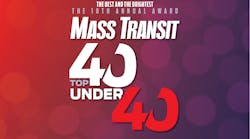- One word to describe yourself: Determined: determined to succeed, provide an effective work product and to advance my career
- Alma mater: I. K. Gujral Punjab Technical University, Colorado Technical University
- Favorite book: I like to read technical and work related documents to keep up on the evolution of our industry. However, away from work, I enjoy reading travel books related to the places that I travel. It help me learn more about the place and the people that have lived there and to know about their culture and customs.
- Favorite TV show: Game of Thrones
- Favorite movie: The Terminal
- Favorite hobby(ies): Traveling
Sam Kaur started her transportation career working for a small engineering firm in India while in school. After immigrating to the United States, she started an internship at the California Department of Transportation (Caltrans), where she was afforded the opportunity to get involved in various departments and able to see the impact of a new bus service, a street or freeway widening, a bride or bike lane. It was that experience that led her to choose a career that could make a difference in the public’s quality of life and help find funding for improvements to get people to their jobs and to their families.
Kaur came to the Metropolitan Planning Organization (MPO) in Stanislaus County, California, in 2004 as a temporary employee. She was the project lead on the Blueprint Program, the precursor to California’s Sustainability Communities Strategy, required by Senate Bill 375 (2008). This was the first of her innovative planning and strategic efforts. The program is focused on the reduction in tailpipe emissions of Greenhouse Gases through effective transportation planning and integration with housing and commercial development.
Kaur continued her innovative work when she moved to the MPO in San Joaquin County. At the height of the housing meltdown and when Stockton, the county seat of San Joaquin County, had the highest foreclosure rate in the nation, Kaur developed the 2008 Smart Growth Program for the San Joaquin Council of Governments (SJCOG). She followed the development of the overarching program with the development of a specific plan, the 2012 San Joaquin County Smart Growth Plan, to inventory and assess vacant and underutilized properties in the county for transit-oriented development and multi-use development. She secured a Caltrans Planning Grant; procured a consultant; managed the consultant contract; and worked with the contractor, a local citizens’ advisory committee, and the local jurisdictions to develop this plan.
In addition to transit planning and funding, Kaur was also responsible for all federal and state programming of funds and in 2012 and 2013, was recognized as the programmer that had brought her MPO to be the highest obligating MPO in the state of California for both years. In these obligation milestones, she programmed extensive funding to help the regional public transportation agency begin their bus rapid transit program.
In 2013 Kaur moved to the OCTA, where she has managed a variety of programs, including updating and implementing the calls for projects for the Comprehensive Transportation Funding Programs; the Regional Capacity Program for Streets and Roads ($32 million annually); the Regional Signal Synchronization Program ($8-$10 million annually); the Community Based Circulators (Authorized $30 million); redeveloped the Project V Guidelines and Scoring Criteria in 2016; and Initiated the Safe Transit Stops Program Frame works and authorized $1.2 million for the busiest Stops in Orange County.
Kaur is currently working in the capacity of department manager for Revenue and Grants Administration at OCTA. She is managing programs such as TIFIA loan agreement with the United States Department of Transportation, sales tax forecast and fare collection systems update.
In her years at OCTA, Kaur has been recognized for her talents, abilities, and commitment to transportation through three promotions in her four years there. She is now the department manager, Revenue and Grants at OCTA.
“I started my career in transportation working for a small engineering firm in India while I was in school. After immigrating to the United States, I started my internship with Caltrans. The internship provided me the opportunity to get involved in various Departments at Caltrans. It was really fascinating to see the impact of a new bus service, street or freeway widening, bridge or a bike lane. I then decided to choose a career that can really make a difference in everyone’s quality of life and help funding the improvements that can get the people to their jobs and families as quickly as possible.”
“I really enjoy the innovation aspect of transportation. It is so important for public agencies, such as OCTA and others, to keep up with the trends as new technologies continue to emerge. I like exploring advancements in technology that can improve transit riders experience and take transit to the next level.”
“[The biggest challenge has been] managing projects or programs that were started with different set of methodologies and practices. However, I like challenges as it can keep me on my toes and leads to creativity, which further drives innovation and generate ideas to help improve our system."
“I am proud to have the opportunity and ability to work on different funding programs including federal, state and local. This has helped me tremendously to communicate the importance of timely project delivery with the available resources.”
“Look for internal and external gaps and be the one to take the initiative to fill those gaps that will help you grow and learn. No projects are too big or too small with the right attitude, team, and leadership, if you have the vision and determination to succeed.”
“The public transit industry serves multiple segments of the population, from the disadvantaged transit-dependent population to the choice riders, creating equality in mobility not seen in other life functions. The more people we attract to public transportation, the fewer cars on the road, reducing tailpipe emissions, collisions and congestion.”




